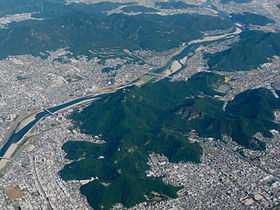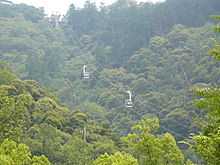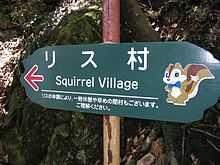Mount Kinka (Gifu)
| Mount Kinka | |
|---|---|
| 金華山 | |
 Mt. Kinka | |
| Elevation | 328.9 m (1,079 ft) |
| Location | |
 Mount Kinka | |
| Location | Gifu, Gifu Prefecture, Japan |
| Range | none |
| Coordinates | 35°26′N 136°46′E / 35.433°N 136.767°ECoordinates: 35°26′N 136°46′E / 35.433°N 136.767°E |
| Topo map | Geographical Survey Institute, 25000:1 白山, 50000:1 白山 |
| Geology | |
| Type | Sedimentary |
| Climbing | |
| Easiest route | Mt. Kinka Ropeway |
Mt. Kinka (金華山 Kinka-zan), also known as Kinkazan, is located in the heart of the city of Gifu, Gifu Prefecture, Japan, and rises to a height of 329 m (1,079 ft). Previously called Mt. Inaba (稲葉山 Inaba-yama), it has long served as the representative symbol of Gifu. It stands along the Nagara River, creating bountiful nature within the city. Though it is the most famous mountain in the city, Mount Dodo, to the north, is the tallest.
History
First built by the Nikaidō family during the Kamakura period, Gifu Castle atop Mt. Kinka has gone through many forms, with the current building being constructed in 1956.[1] One of its first major residents was Saitō Dōsan, who lived in the castle when it was still being called Inabayama Castle and the mountain was still called Mt. Inaba. The next resident of the castle, Oda Nobunaga, changed the castle's name at the same time that he changed the name of the surrounding town and the mountain.
The castle eventually fell into disrepair and vanished from Gifu's skyline. However, it was rebuilt in 1956 and that is the castle that still stands today. During reconstruction, tiles were carried to the top by volunteers. Those who helped were able to write messages on the roof tiles before they were put in place. Those who helped were able to experience what it was like when the castle was originally built many years before. From the top of the castle, visitors have a 360-degree view, effectively giving them a view to all the borders of the city of Gifu. Inside the castle are many artifacts from its past.
Centuries ago, the mountain was protected as a hunting ground for the Owari Clan, preserving the trees from being used to build the area as it grew from a small town to a large city. Today, the forest is designated as a national forest,[2] giving protection to the over 700 types of plants and 80 types of birds that can be found on the mountain.
In 2005, the top of the mountain was renovated, adding lights and walkways to improve the ease of use to visitors of the castle.[3] The new signs provide additional information about the castle and the surrounding structures, while the lights add to the allure of the castle's panoramic night viewing.
Reaching the summit

The other option for reaching the summit is by taking the Mt. Kinka Ropeway, which first opened in 1955.[3] This ropeway enables visitors to reach the top of the mountain in less than five minutes. The hours of operation for the ropeway vary depending on the seasons throughout the year, but it is generally open from 9:00am to 6:00pm. On weekdays, it runs every 15 minutes, while on weekends and holidays, it runs every 10 minutes.[6]
Summit attractions

Area attractions
Additionally, there are many attractions at the base of Mt. Kinka.
- Gifu City Museum of History
- Gifu Park
- Eizō & Tōichi Katō Memorial Art Museum
- Inaba Shrine
- Site of Oda Nobunaga's Former Residence, Senjō-jiki (千畳敷)
- Nawa Insect Museum
References
- ↑ Gifu Prefecture: Japan's Beautiful Heartland. Gifu International Center, 1994.
- ↑ Gifu City Tourist Information. Gifu City Hall. Accessed November 13, 2007.
- ↑ 3.0 3.1 Outline of Gifu City 2005. Gifu City Hall, April 2005.
- ↑ Mt. Kinka Hiking Trails. (Japanese) Gifu City Hall. Accessed June 12, 2007.
- ↑ Outline of Gifu City 2006. Gifu City Hall, April 2006.
- ↑ 6.0 6.1 Kinkazan, Kinkazan Co. Access June 12, 2007
| Wikimedia Commons has media related to Mount Kinka (Gifu). |